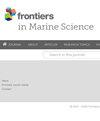Evaluating zooplankton species diversity using environmental DNA and bulk-DNA metabarcoding in the Ulleung Basin of the Southeastern Korean Peninsula in the summer
IF 2.8
2区 生物学
Q1 MARINE & FRESHWATER BIOLOGY
引用次数: 0
Abstract
Accurately investigating the composition of zooplankton species is crucial for monitoring changes in marine ecosystems and assessing biodiversity. In this study, we utilized bulk DNA and environmental DNA metabarcoding in the Ulleung Basin, known for its high zooplankton species diversity among the seas surrounding the Korean Peninsula. Genomic DNA extracted from samples collected during three summer seasons in the survey area was analyzed using high-throughput sequencing of the cytochrome c oxidase I barcode region. We identified 350 species, which were three to six times more than those identified by traditional morphological methods. Furthermore, we observed significant differences in species composition and diversity between bulk DNA and eDNA samples. Notably, eDNA metabarcoding effectively detected species with high swimming ability and those that were difficult to capture using traditional sampling methods. This study underscores the significant impact of sampling methods on research outcomes in zooplankton species diversity studies and highlights the importance of integrating different sampling techniques. Specifically, it suggests the need for the active adoption of non-invasive methods, such as eDNA metabarcoding, for the comprehensive monitoring of diverse biological groups in marine ecosystems.利用环境 DNA 和大容量 DNA 代谢编码评估夏季朝鲜半岛东南部郁陵盆地浮游动物的物种多样性
准确调查浮游动物的物种组成对于监测海洋生态系统的变化和评估生物多样性至关重要。在这项研究中,我们在郁陵盆地采用了大量 DNA 和环境 DNA 代谢编码技术,郁陵盆地在朝鲜半岛周边海域中以浮游动物物种多样性高而著称。我们利用细胞色素 c 氧化酶 I 条形码区的高通量测序技术,分析了从调查区三个夏季采集的样本中提取的基因组 DNA。我们确定了 350 个物种,比传统形态学方法确定的物种多三到六倍。此外,我们还观察到大量 DNA 样本和 eDNA 样本在物种组成和多样性方面存在明显差异。值得注意的是,eDNA 代谢标码能有效地检测到游泳能力强的物种以及传统取样方法难以捕获的物种。这项研究强调了取样方法对浮游动物物种多样性研究成果的重要影响,并突出了整合不同取样技术的重要性。具体而言,该研究表明有必要积极采用非侵入性方法(如 eDNA 代谢编码)来全面监测海洋生态系统中的各种生物群体。
本文章由计算机程序翻译,如有差异,请以英文原文为准。
求助全文
约1分钟内获得全文
求助全文
来源期刊

Frontiers in Marine Science
Agricultural and Biological Sciences-Aquatic Science
CiteScore
5.10
自引率
16.20%
发文量
2443
审稿时长
14 weeks
期刊介绍:
Frontiers in Marine Science publishes rigorously peer-reviewed research that advances our understanding of all aspects of the environment, biology, ecosystem functioning and human interactions with the oceans. Field Chief Editor Carlos M. Duarte at King Abdullah University of Science and Technology Thuwal is supported by an outstanding Editorial Board of international researchers. This multidisciplinary open-access journal is at the forefront of disseminating and communicating scientific knowledge and impactful discoveries to researchers, academics, policy makers and the public worldwide.
With the human population predicted to reach 9 billion people by 2050, it is clear that traditional land resources will not suffice to meet the demand for food or energy, required to support high-quality livelihoods. As a result, the oceans are emerging as a source of untapped assets, with new innovative industries, such as aquaculture, marine biotechnology, marine energy and deep-sea mining growing rapidly under a new era characterized by rapid growth of a blue, ocean-based economy. The sustainability of the blue economy is closely dependent on our knowledge about how to mitigate the impacts of the multiple pressures on the ocean ecosystem associated with the increased scale and diversification of industry operations in the ocean and global human pressures on the environment. Therefore, Frontiers in Marine Science particularly welcomes the communication of research outcomes addressing ocean-based solutions for the emerging challenges, including improved forecasting and observational capacities, understanding biodiversity and ecosystem problems, locally and globally, effective management strategies to maintain ocean health, and an improved capacity to sustainably derive resources from the oceans.
 求助内容:
求助内容: 应助结果提醒方式:
应助结果提醒方式:


